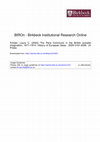Conference Papers by Laura C Forster
Papers by Laura C Forster

History of European Ideas, 2020
This article is concerned with manifestations of the memory of the Paris Commune in Britain in th... more This article is concerned with manifestations of the memory of the Paris Commune in Britain in the decades after the Commune was defeated. It is about how the Commune was incorporated into the mythology, the canon, of British socialism, and how the memory of the Commune furnished British socialism with powerful and useful symbols. In highlighting the ways in which the events of 1871 captured the British socialist imagination, what follows shows how, despite its oft-emphasised insularity, British socialism was made through the incorporation and appropriation of both native and foreign ideas, symbols, and traditions. The powerful mythologies and symbolism associated with the Commune were taken up by socialists in Britain, and highlight an important intersection between British and French political cultures in the late nineteenth and early twentieth centuries.

The Historical Journal, 2019
ABSTRACTFollowing the Paris Commune of 1871, around 3,500 Communard refugees and their families a... more ABSTRACTFollowing the Paris Commune of 1871, around 3,500 Communard refugees and their families arrived in Britain, with the majority settling in the capital. This article is an exploration of these exiled Communards within the geography of London. The spatial configurations of London's radical and exile communities, and the ways in which Communards interacted with those they crossed paths with, is vital in understanding how some of the ideas that came out of the Commune permeated London's radical scene. Too often British political movements, particularly British socialism, have been presented as being wilfully impervious to developments on the continent. Instead, this article argues that in order to find these often more affective and ancillary foreign influences, it is important to think spatially and trace how the exile map of London corresponded with, extended, and redrew parts of the existing radical mapping of the city. In carving out spaces for intellectual exchange, ...

History Workshop Journal
The memory of the Paris Commune of 1871 has long been summoned as an example of urban revolutiona... more The memory of the Paris Commune of 1871 has long been summoned as an example of urban revolutionary struggle. In 2011 a Parisian street art collective, RaspouTeam, produced a series of commemorative installations across Paris to mark the 140th anniversary of the Commune. They intended the project to make an explicit link between the politics of the Paris Commune of 1871, and the politics of public space in the twenty-first century city. 2021 marks the 150th anniversary of the Commune. In the last decade the struggle to halt the encroachment of capital upon community and the demand for democratic public spaces (as called for by the Communards of Paris) have remained at the forefront of urban political projects. As pseudo-public open spaces and corporate-owned urban areas present new battlegrounds for economic and social justice protests in cities across the globe, the anniversary of the Paris Commune offers an opportunity to reflect on how and why we remember radical urban resistance...
History of European Ideas , 2020
This article is concerned with manifestations of the memory of the Paris Commune in Britain in th... more This article is concerned with manifestations of the memory of the Paris Commune in Britain in the decades after 1871. It is about how the Commune was incorporated into the mythology, the canon, of British socialism, and how the memory of the Commune furnished British socialism with powerful and useful symbols. In highlighting the ways in which the events of 1871 captured the British socialist imagination, what follows shows how, despite its oft-emphasised insularity, British socialism was made through the incorporation and appropriation of both native and foreign ideas, symbols, and traditions. The powerful mythologies and symbolism associated with the Commune were taken up by socialists in Britain, and highlight an important intersection between British and French political cultures in the late nineteenth and early twentieth centuries.

The Historical Journal , 2019
Following the Paris Commune of 1871, around 3,500 Communard refugees and their families arrived i... more Following the Paris Commune of 1871, around 3,500 Communard refugees and their families arrived in Britain, with the majority settling in the capital. This article is an exploration of these exiled Communards within the geography of London. The spatial configurations of London's radical and exile communities, and the ways in which Communards interacted with those they crossed paths with, is vital in understanding how some of the ideas that came out of the Commune permeated London's radical scene. Too often British political movements, particularly British socialism, have been presented as being wilfully impervious to developments on the continent. Instead, this article argues that in order to find these often more affective and ancillary foreign influences, it is important to think spatially and trace how the exile map of London corresponded with, extended, and redrew parts of the existing radical mapping of the city. In carving out spaces for intellectual exchange, Communard refugees moved within and across various communities and physical places. The social and spatial context in which British sympathizers absorbed and appropriated ideas from the Commune is key to understanding how the exiles of the Paris Commune left their mark on the landscape, and mindscape, of London.

Uploads
Conference Papers by Laura C Forster
Papers by Laura C Forster